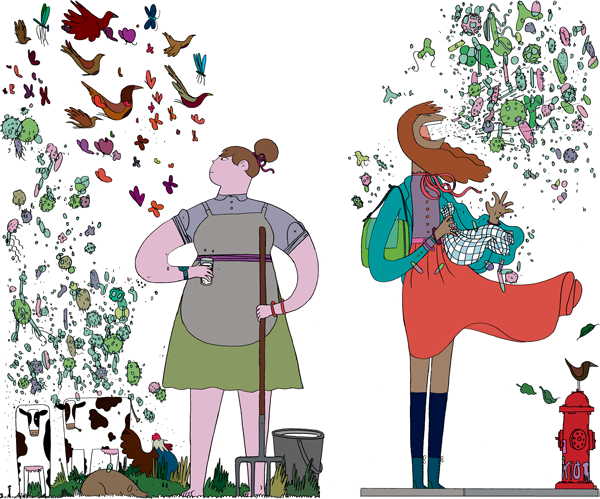“Will the cure for allergies come from the cowshed?” begins a terrific opinion piece in Sunday’s New York Times by Moises Velasquez-Manoff, author of “An Epidemic of Absence”. He makes yet another case in support of the “hygiene hypothesis” which posits that the absence of microbes in the food and environment of the developed world is robbing us of important agents that help train our immune systems as they develop.
The article highlights an Amish community in Indiana where the incidence of asthma and allergies is remarkably low. In this agrarian society, people are exposed to a wealth of microbes from the point of conception as their mothers work their farms. Later, the children learn to walk in the barns and eventually participate in farming chores, continuing their exposure to the microbes, mold and fungi that are endemic to the life style.
This continued exposure, dubbed the “farm effect”, is suspected of helping to train the immune system to self-regulate. The hypothesis is founded on the theory that humans evolved in the presence of these stimuli, and their absence in the developed world prevents our immune systems from maturing appropriately, thus leading to allergies.
The author makes the case for further study of the farm effect in the hope that key microbes can be identified to help researchers better understand the cause of allergies and develop effective treatments.
Velasquez-Manoff’s piece is well worth the read. Find the article here.






Every time I see another rah-rah article on the hygiene hypothesis, I just shudder. The hygiene hypothesis is an awfully convenient diversion of attention from the corporate food industry in the U.S. and its likely culpability in the rapid rise of food allergies. There is plenty of evidence of GMOs and other such tampering with our food supply is at least a partial cause in the rise of food allergies in our country. Robyn O’Brien’s TED talk is a great place to start. http://www.youtube.com/watch?v=rixyrCNVVGA
When the author of this article states that Dr. Holbreich has ‘made his point’, I disagree wholeheartedly. The only point he has made is that the Amish community he studied spends a lot of time with cows and has low incidence of allergies. However, there are 450 Amish settlements in 28 states and in Ontario, and the study’s small sample size is worth noting.
The first questions that came into my mind were about the Amish people’s diets. How much processed food did they eat? Did they consume any GMOs? Did the mothers consume GMOs while pregnant? Did they plant and grow any crops that were genetically modified? Did they shop at the local grocery store, or was the vast majority of what they ate produced by themselves? Did they use pesticides, herbicides, or fertilizers on their crops?
I also find it interesting that the increase in allergies of people who are ‘westernized’ by moving to the U.S. from other countries is attributed to the lack of cow exposure they get once they move here. What about the ‘westernization’ that is taking place via their introduction to our ultra-processed, chemical-laden, genetically modified foods? What about the overuse of antibiotics in the U.S., both in humans and animals?
This article is overly simplistic and is masquerading as useful information. It would be enlightening to find out who has been funding Dr. Holbreich’s research. Perhaps big ag or industrial food producers?
The Amish do not receive our vaccines and antibiotics creating weak gut and genetic change also part of the hygiene hypothesis.